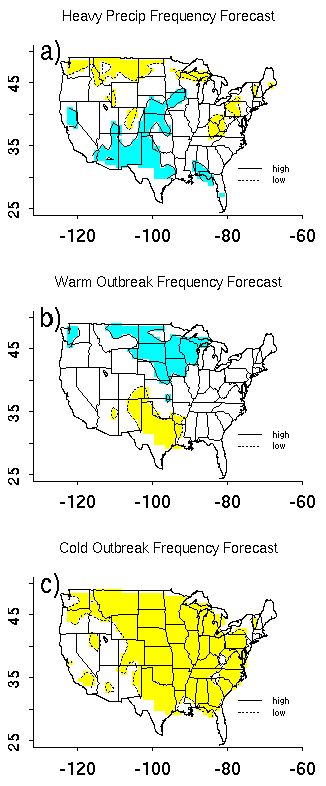

Statistical Forecast of the Extreme Precipitation and Temperature Event Frequencies for December-January-February 1997/98.
 The categorical
ENSO-phase-based statistical forecasting scheme uses the hybrid
coupled model prediction of ENSO phase and intensity defined by NINO
3.4 SST and also takes into account the current phase of the north Pacific
decadal oscillation. Results are based on 60 winters (1934-1993) of daily
precipitation and temperature data recorded at 168 US stations. Forecasts
are issued in three categories (low, average and high) defined by the terciles
of the 60-winter climatology of heavy rainfall frequency (HRF), extreme
warm (EWF) and extreme cold (ECF) outbreak frequencies. A heavy rainfall
event is defined by daily precipitation totaling more than the 75th percentile
of the local DJF daily rainfall climatology. Extreme warm (cold) events
are defined by daily average temperature above (below) the 90th (10th)
percentile of the DJF daily rainfall climatology at each station. The forecasted
category is the one containing the mean of a variable (HRF, EWF or ECF)
for past winters characterized by similar climatic conditions in the Pacific
to those predicted by coupled models and persistence for the coming winter.
Skill is assessed via cross-validation techniques and statistical significance
is estimated via bootstrap resampling. Only those predictions in the low
and high categories with skill levels significant at the 0.05 level of
significance are displayed.
The categorical
ENSO-phase-based statistical forecasting scheme uses the hybrid
coupled model prediction of ENSO phase and intensity defined by NINO
3.4 SST and also takes into account the current phase of the north Pacific
decadal oscillation. Results are based on 60 winters (1934-1993) of daily
precipitation and temperature data recorded at 168 US stations. Forecasts
are issued in three categories (low, average and high) defined by the terciles
of the 60-winter climatology of heavy rainfall frequency (HRF), extreme
warm (EWF) and extreme cold (ECF) outbreak frequencies. A heavy rainfall
event is defined by daily precipitation totaling more than the 75th percentile
of the local DJF daily rainfall climatology. Extreme warm (cold) events
are defined by daily average temperature above (below) the 90th (10th)
percentile of the DJF daily rainfall climatology at each station. The forecasted
category is the one containing the mean of a variable (HRF, EWF or ECF)
for past winters characterized by similar climatic conditions in the Pacific
to those predicted by coupled models and persistence for the coming winter.
Skill is assessed via cross-validation techniques and statistical significance
is estimated via bootstrap resampling. Only those predictions in the low
and high categories with skill levels significant at the 0.05 level of
significance are displayed.
Last modified: 24 July 1997
Contact: gershuno@cayman.ucsd.edu